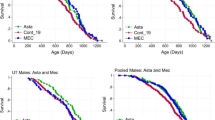Abstract
In two fully crossed, two-factor experiments, F1 generation male rats were fed a basal diet supplemented with lead (lead acetate) at 0 or 2 μg/g and iron (ferric sulfate) at 50 or 250 μg/g (Experiment 1). Supplements in Experiment 2 were lead at 0 or 1 μg/g and iron at 50, 250, or 1000 μg/g. After 28 or 50 d in Experiment 1, and 35 d in Experiment 2, a relationship between lead and iron was found. Body weight was lower in low-lead than lead-supplemented 28-d-old rats regardless of dietary iron, whereas hematocrit and hemoglobin were lower in low-lead than lead-supplemented rats fed 50 μg iron/g diet. A similar finding was obtained with hematocrit and hemoglobin in 35-d-old rats. Dietary lead did not affect rats fed 250 or 1000 μg iron/g diet. Also, feeding low dietary lead did not affect 50-d-old rats regardless of dietary iron. Liver and bone concentrations of lead were markedly affected by dietary lead and iron. The concentration of lead in liver and bone was lower in low-lead than lead-supplemented rats. Compared to rats fed 50 μg iron/g diet, rats fed 250 μg iron/g diet exhibited a decreased lead concentration in liver and bone. This decrease was accentuated by lead supplementation. The findings suggest that lead acted pharmacologically to affect iron metabolism in rats.
Similar content being viewed by others
References
K. Schwarz, inTrace Element Metabolism in Animals, vol. 2, W. G. Hoekstra, J. W. Suttie, H. E. Ganther, and W. Mertz, eds., Univ. Park Press, Baltimore, MD, 1974, pp. 355–380.
A. M. Reichlmayr-Lais and M. Kirchgessner,Z. Tierphysiol. Tierernahrg. u. Futtermittelkde.,46, 1 (1981).
A. M. Reichlmayr-Lais and M. Kirchgessner,Arch. Tierernahrg. 31, 731 (1981).
A. M. Reichlmayr-Lais and M. Kirchgessner,Z. Tierphysiol. Tierernahrg. u. Futtermittelkde,46, 8 (1981).
M. Kirchgessner and A. M. Reichlmayr-Lais, inTrace Element Metabolism in Man and Animals, vol. 4, J. McC. Howell, J. M. Gawthrone, and C. L. White, eds., Australian Academy of Science, Canberra, 1981, pp. 390–393.
A. M. Reichlmayr-Lais and M. Kirchgessner,Z. für Tierphysiologie Tierernahrung und Futtermittelkunde,46, 145 (1981).
M. Kirchgessner and A. M. Reichlmayr-Lais,Biol. Trace Element Res. 3, 279 (1981).
M. Kirchgessner and A. M. Reichlmayr-Lais,Inter. J. Vit. Nutr. Res. 51, 421 (1981).
A. M. Reichlmayr-Lais and M. Kirchgessner,Zbl. Vet. Med. A. 28, 410 (1981).
M. Kirchgessner and A. M. Reichlmayr-Lais,Ann. Nutr. Metab. 26, 50 (1981).
A. M. Reichlmayr-Lais and M. Kirchgessner,Ann. Nutr. Metab. 25, 281 (1981).
F. H. Nielsen, D. R. Myron, S. H. Givand, and D. A. Ollerich,J. Nutr. 105, 1607 (1975).
E. Pietsch, G. Blinoff-Achapkin, H. Gruss, A. Kotowski, M. DuMarie and G. Nachod, inGmelins Handbuch der Anorganischen Chemie, Verlag Chemie, Berlin, 1957, pp. 439–462.
F. H. Nielsen, T. R. Shuler, T. J. Zimmerman, M. E. Collings, and E. O. Uthus,Biol. Trace Element Res. 1, 325 (1979).
W. E. Harris and B. Kratochvil, inChemical Separation and Measurements, Saunders, Philadelphia, PA, 1974, pp. 124–132.
F. H. Nielsen and B. Bailey,Lab. Anim. Sci. 29, 502 (1979).
F. H. Nielsen, D. R. Myron, S. H. Givand, T. J. Zimmerman, and D. A. Ollerich,J. Nutr. 105, 1620 (1975).
D. C. Manning and W. Slavin,Anal. Chem. 50, 1234 (1978).
H. Scheffé,The Analysis of Variance, Wiley, New York, 1959, pp. 90–137.
P. N. Davis, L. C. Norris, and F. H. Kratzer,J. Nutr. 78, 445 (1962).
A. R. Sherman, H. A. Guthrie, I. Wolinsky, and I. M. Zulak,J. Nutr. 108, 152 (1978).
K. R. Mahaffey-Bix and R. A. Goyer,J. Lab. Clin. Med. 79, 128 (1972).
K. R. Mahaffey,Nutr. Rev. 39, 353 (1981).
G. B. Forbes and J. C. Reina,J. Nutr. 102, 647 (1972).
K. Kostial, I. Simonovic, and M. Pisonic,Nature 233, 564 (1971).
A. Cantarow and M. Trumper, inLead Poisoning, Williams and Wilkins, Baltimore, MD, 1944, pp. 45–49.
L. Pecora, S. Fati, R. Molé, and C. Pesaresi, inProceedings XIV International Congress on Occupational Health, vol. III, Madrid, 1963, pp. 1068–1069.
Author information
Authors and Affiliations
Rights and permissions
About this article
Cite this article
Uthus, E.O., Nielsen, F.H. Effects in rats of iron on lead deprivation. Biol Trace Elem Res 16, 155–163 (1988). https://doi.org/10.1007/BF02797100
Received:
Accepted:
Issue Date:
DOI: https://doi.org/10.1007/BF02797100




